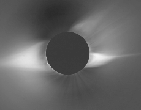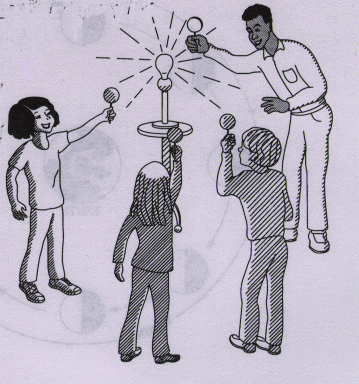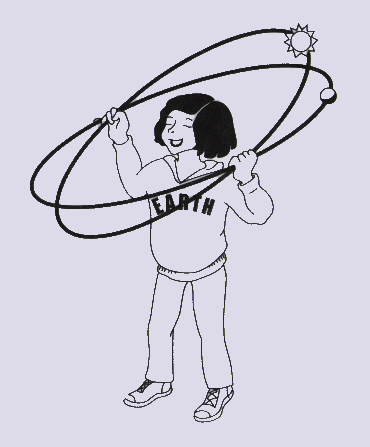Modeling Eclipses 
An activity designed by Dennis Schatz of the Pacific Science Center.

Using a small styrofoam ball, a light bulb, and your students' heads, let's try to understand how eclipses work.
Ask the students if they can define an eclipse and if they know the difference between a solar and a lunar eclipse. Explain to them students that we can understand eclipses by looking at models of the Sun, Moon, and Earth.
1 - Place a light bulb on a stand or clamp at the front of your room and turn it on. (Remove the lampshade, please.)
2 - Have the students stick a pencil into their styrofoam balls so they can easily hold them.
3 - Ask your students to stop playing with the balls.
4 - Darken the room as much as possible.
5 - Have the students stand in a semicircle facing the lamp, holding their pencil/balls at arm's length. Explain to them the light represents our Sun, the styrofoam ball the Moon, and the students' heads our Earth.

Have the students move the balls around their heads to model the rotation of the Moon around the Earth. Have them move the Moon ball in orbit until it completely blocks their view of the Sun/lamp. Explain to them that when the Moon is positioned between the Earth and the Sun, a solar eclipse occurs.
Have the students position their ball so it's directly opposite the Sun, with their head casting a shadow onto the ball. Explain that when the Moon passes into the Earth's shadow, we have a lunar eclipse.
Do more people see a solar eclipse, or a lunar eclipse? Have you students watch the sizes of the shadows to decide. It's helpful to have them look at a friend's face during their solar "eclipse". How big is the shadow that falls on their face?
Most people on the dark side of the Earth can see the Moon when it is eclipsed. But only a very few can see a solar eclipse, because the shadow falls on only a small part of the Earth at a time.You can experiment with lunar phases as well. What phase is the Moon in during a solar eclipse (new moon)? A lunar eclipse (full moon)?
Now that your students understand what causes an eclipse, ask them to think about how often there should be solar and lunar eclipses. Ask them to experiment with their models. Do they know how long it takes for the Moon to orbit the Earth (about a month, or "moonth"). Can they come up with a list of predictions for how often solar and lunar eclipses should occur?
If the Moon were orbiting in the exact plane between the Earth and the Sun, we might have a lunar and a solar eclipse once a month. However, the Moon's orbit is tilted to the plane of the Sun.
You can demonstrate this by holding two hula hoops over your head, slightly askew to each other. The hoops represent the pth of the Sun and the Moon as seen from the Earth (your head). (Don't let the kids get confused into thinking the Sun orbits the Earth!). One hoop represents the Moon's (monthly) path, the other the Sun's (yearly) path. ` Ask the students where the Moon and Sun have to be to produce an eclipse? (At the crossing points. Now, how often do the Sun and the Moon reach those crossing points? (Two crossing points -- so twice a year.)


Back to the SOLAR Center
Comments?
Sketches from the Project Astro "The Universe at Your Fingertips" resource notebook; Astronomical Society of the Pacific.
https://solar-center.stanford.edu/eclipse/model.html
Copyright © 1998 Stanford University. All rights reserved.
Created by Deborah Scherrer 11 Feb 1998
Last modified by DKS on 10 Feb 98.